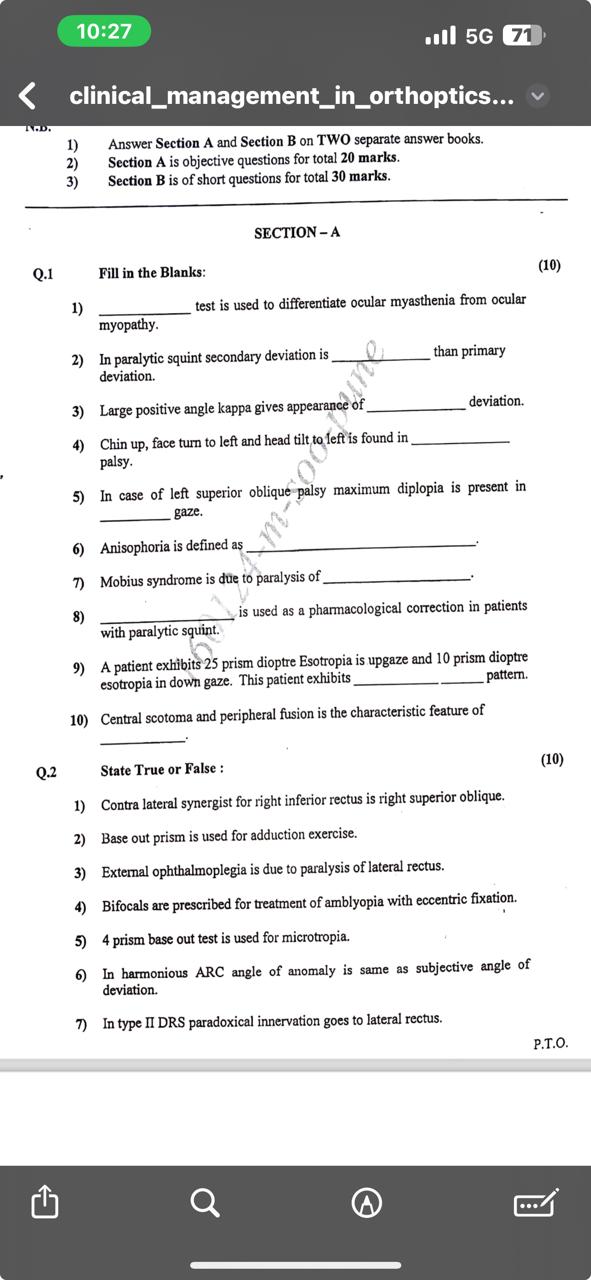Fill in the blanks: 1) ____________ test is used to differentiate ocular myasthenia from ocular myopathy. 2) In paralytic squint, secondary deviation is ____________ than primary d... Fill in the blanks: 1) ____________ test is used to differentiate ocular myasthenia from ocular myopathy. 2) In paralytic squint, secondary deviation is ____________ than primary deviation. 3) Large positive angle kappa gives appearance of ____________ deviation. 4) Chin up, face turn to left and head tilt to left is found in ____________ palsy. 5) In case of left superior oblique palsy, maximum diplopia is present in ____________ gaze. 6) Anisophoria is defined as ______________________. 7) Mobius syndrome is due to paralysis of ______________________. 8) ____________ is used as a pharmacological correction in patients with paralytic squint. 9) A patient exhibits 25 prism dioptre esotropia is upgaze and 10 prism dioptre esotropia in downgaze. This patient exhibits ____________ pattern. 10) Central scotoma and peripheral fusion is the characteristic feature of ____________. State True or False: 1) Contra lateral synergist for right inferior rectus is right superior oblique. 2) Base out prism is used for adduction exercise. 3) External ophthalmoplegia is due to paralysis of lateral rectus. 4) Bifocals are prescribed for treatment of amblyopia with eccentric fixation. 5) 4 prism base out test is used for microtropia. 6) In harmonious ARC angle of anomaly is same as subjective angle of deviation. 7) In type II DRS, paradoxical innervation goes to lateral rectus.

Understand the Problem
The question consists of fill-in-the-blank and true or false statements related to ophthalmology and orthoptics, specifically focusing on various conditions, tests, and classifications relevant to ocular alignment and muscle function.
Answer
1) Tensilon, 2) Greater, 3) Outward, 4) Left superior oblique, 5) Downward, 6) Difference in phoria between distance and near, 7) VI (abducens) and VII (facial), 8) Botulinum toxin, 9) A, 10) Microtropia. True or False: 1) False, 2) False, 3) False, 4) False, 5) True, 6) True, 7) True.
The final answers are provided below.
Answer for screen readers
The final answers are provided below.
More Information
For the fill-in-the-blank part: 1) The Tensilon test is used to differentiate ocular myasthenia from ocular myopathy, 2) In paralytic squint, secondary deviation is greater than primary deviation. 3) A large positive angle kappa gives the appearance of outward deviation. 4) Chin up, face turn to the left and head tilt to the left is found in left superior oblique palsy. 5) In the case of left superior oblique palsy, maximum diplopia is present in downward gaze. 6) Anisophoria is defined as the difference in phoria between distance and near. 7) Mobius syndrome is due to paralysis of the VI (abducens) and VII (facial) cranial nerves. 8) Botulinum toxin is used as a pharmacological correction in patients with paralytic squint. 9) A patient who exhibits 25 prism dioptres esotropia in upgaze and 10 prism dioptres esotropia in downgaze exhibits a A pattern. 10) Central scotoma and peripheral fusion is the characteristic feature of microtropia. For the true or false part: 1) False (Contra lateral synergist for right inferior rectus is right superior oblique), 2) False (Base out prism is not used for adduction exercise), 3) False (External ophthalmoplegia is not due to paralysis of lateral rectus), 4) False (Bifocals are not prescribed for treatment of amblyopia with eccentric fixation), 5) True (4 prism base out test is used for microtropia), 6) True (In harmonious ARC angle of anomaly is the same as subjective angle of deviation), 7) True (In type II DRS paradoxical innervation goes to the lateral rectus).
Tips
Carefully differentiate between different types of strabismus and tests used in diagnosis complexes to avoid confusion.
Sources
- Video-Oculography for the Diagnosis of Ocular Myasthenia Gravis - ncbi.nlm.nih.gov
- Strabismus (Squint) | Ento Key - entokey.com
- Myasthenia Gravis - EyeWiki - eyewiki.org